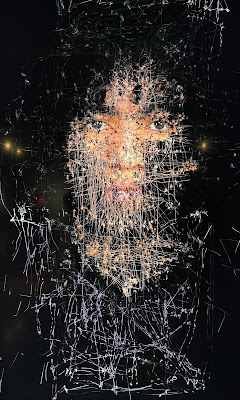I had the real pleasure of visiting the current exhibition Arteonica at the Museum of Latin American Art in Long Beach, CA. There were the works of several artists, from Chile, Argentina, Mexico, Switzerland, Brazil.
The work that impacted me the most was "Wall of Gazes" by Argentinians Mariano Sardón and (neuroscientist) Mariano Sigman. The videos, depicted as transforming portraits were mesmerizing.
From Ars Electronica:
"The Wall of Gazes consists of one screen in which visitors can see how portrait images are revealed by the eye movements of many persons simultaneously. Gazes were captured by an eye tracker device. Around 100 participants were seated in front of a portrait image and the device recorded their gazes for 15 seconds. The screen is connected to a computer and a special software displays the eye tracks stored in a database. Portraits are ever-changing composition, according the gazes captured and displayed by the software."
The eye tracking data was generated at the Muntref Centro de Arte y Ciencia. Universidad Nacional de Tres de Febrero. Buenos Aires.
It immediately came to my mind the relationship between architectural perception and neuroscience. I researched a little more about this project, and I was pleased to see that it was applied to migrants' memories, to movement, from one country to another as well.
From Mariano Sigman's page:
"Hiwa K tells that border officer ask immigrants questions about the map of his hometown. Most immigrants, like anyone who is asked random questions about the geography of their city, fail the test. This story is the inspiration of our project. We live in small, sparse fragments of our city. The road to school, the bus to our grandmother’s house, the square where time passed relentlessly. Each person has her own city. In this work we investigate this distant memory of an individual’s memory of the city in which they lived. We looked a map while we heard stories by people who moved from Mexico to the United States, from Syria to Austria, from Bolivia to Argentina. Then we reconstruct this, cutting the trajectory of the eyes on a paper map. Because of its own lightness, this map bends when it leans on wood and forms bridges that connect places that are distant in the city, but close in memory."
I think that it would be a step forward to "measure" the perceptions on the architecture that is affected by the dwellers' memories and traditions. In other words, to leave the 2 dimension of the map and see what happens when people is confronted with cultural information on the built environment. And which is the perception of people while observing this, depending on their nationalities and or their studies degree, their intellectuality. For example, I was walking in my neighborhood and saw the -following- homage for the Day of the Dead. The neighbors, I assume, must be Mexican or descendants, but living in the USA, and are expressing themselves with their hearts. Regretting the losses of their young relatives.
These articulations, the fine details, the offerings, have a real impact on architecture, the altar is like becoming part of it. The facade is completely integrated to the force of culture. Definitely, the three dimension would be worth of farther analysis.
Altar in my neighborhood, Long Beach, CA. From my personal archives, November 2024.













